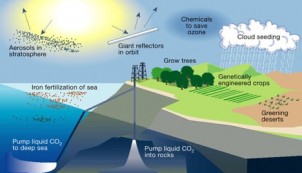
Joan Martinez-Alier.
When we wrote the EJOLT project three years ago, we selected a wide range of environmental justice conflicts: from extraction to waste and from nuclear to biomass. But we left aside some relatively new and upcoming types of environmental conflicts. There is the recent boom in shale gas fracking. And serious questions arise on geoengineering experiments. Last autumn, the world’s largest geoengineering experiment caused a much needed public debate. The incident revealed the urgent need for ecological economists, political ecologists and activists to dig deeper in this issue.
Geoengineering is the intentional, large-scale technological manipulation of the Earth’s systems, often discussed as a techno-fix for combating climate change. But scientists and engineers do not operate in a vacuum. Once they produced a technology, entrepreneurs and governments will decide where and when to use it. But what if these technologies have uncertain far reaching and long lasting impacts on a vast number of people, if not the whole world population? That is their aim, by altering the climate. But then how can other stakeholders than scientists, entrepreneurs and governments be brought into such a crucial dialogue? Can they bring the incommensurability of values or the unequal distribution of costs and benefits to the table? Can they influence decisions that affect them on such a vast and deep scale?
It has been rightly written by the Earth Institute at Columbia University that “Governance is perhaps the thorniest aspect of geoengineering. Because geoengineering is a relatively cheap way to address climate change, it is unilateral—rich countries and billionaires could finance it on their own – yet the consequences would be global. Who then should get to control geoengineering, and under what governance? Some strategies would benefit certain countries and harm others, so who would have the right to decide whether, when and how to use it? Geoengineering would likely create winners and losers – should losers be compensated?”.
How uncertain risks, costs and benefits of environmental actions or inactions are distributed among contemporary human groups, and with future generations and other species, is the stuff of Political Ecology. There are already some advances in the field of Political Ecology on Climate Engineering. But an inventory of such studies should be carried out, within EJOLT or in new research.
One should start with ETC’s impressive inventory and map of 300 Climate Engineering projects and experiments, correcting mistakes or omissions in agreement with ETC itself. The ETC group has been at the vanguard of civil society engagement with geoengineering. Then, a smaller but in-depth inventory of conflictive cases, is urgently needed. We need to look at the social actors involved, the valuation languages deployed and we need to ask if the principle “losers should be compensated” should be prioritized above the principle of “the incommensurability of values”.
The ETC map is both an outcome of and a subject for new research. It claims plausibly to be a “world map of geoengineering – the large-scale manipulation of earth or climate systems”. While there is no complete record of the scores of weather and climate control projects in dozens of countries, this map is the first attempt to document the expanding scope of research and experimentation. The geoengineering experiments on the map belong to 10 different types of climate-altering technologies. The science around geoengineering is proceeding much faster than the critical reflections by scientists or the watchdog operations by activists.
If there is one thing that the map already teaches us, it’s the urgent need for a public debate infused with knowledge from different scientific disciplines and a range of activists and concerned citizens.



I am featuring this map in a 3D google earth website called ClimateViewer 3D.
I am currently adding all the NOAA reported weather modification projects, however the map features several hundred projects already.
ClimateViewer 3D climate engineering map here: http://climateviewer.com/earth/
Climate Engineering Exposed!
http://climateviewer.com/climate-engineering-exposed/
It will be difficult to start serious political ecological work on geoengineering because so little “geoengineering” has actually been done in the real world. If you want to do in-depth case studies, you could probably count the prospective instances on one hand. Most of the “developments” in geoengineering happen in the sphere of ideas– models, articles, reports on research strategies, etc. The problematic ETC map makes it seem like the world is being geoengineered because it includes local biochar projects and weather modifications together with research on large-scale geoengineering– hardly commensurate categories. If anything, governments have shown a lack of commitment to funding geoengineering research (and climate change research in general, considering the scope of the problem). This doesn’t mean that there shouldn’t be political ecological studies of geoengineering in the future– it’s just hard to research something that hasn’t happened yet. If someone has some ideas on how to proceed, please let me know; I would be interested. warmly, Holly
Pingback: Another Week of GW News, January 13, 2012 – A Few Things Ill Considered